
|

Syria and Lebanon
Wilfred Thesiger once told me that the one person he always wanted to meet was T E Lawrence. Lawrence died in 1935, at which point Wilfred was 26. They both came from relatively well-to-do families and both had the appropriate connections in Government and the Military. It was a missed opportunity and a regret that Wilfred carried for the rest of his life. Anyway, that is how I became interested in T E Lawrence and what he did in his life. I have walked the length of Wadi Rum and been to the Fort at Aqaba which Lawrence helped the Arabs to capture. I have been to his house Clouds Hill, Bovington Army Camp where he died, seen the marble carving at the Saxon church at St Martin-On-The-Walls and his grave at Moreton Village Churchyard. Now I wanted to find out what it was that made him so interested in the Middle East and its peoples. 
Whilst gathering information I learnt that he studied archaeology at Oxford which took him on trips to Palestine and Syria and that he wrote a paper whilst at university which was later printed as the book ‘Crusader Castles’, a reprinted copy of which I have managed to acquire. Within the pages are many interesting and inspiring photographs but my attention was immediately drawn to Krak des Chevaliers and it was to see this that inspired me to travel to Syria. So, what of my travelling companion, Lucy? I first met her on an expedition in Bolivia in 2004, and I developed a great deal of admiration for her. Physically fit, resourceful and with a kindred sense of humour she was a fantastic person to travel with then and on this trip. The next time Lucy and I met following Bolivia, two or so months later, was at a Scientific Expedition Society (SES) social function on a house-boat in Chelsea. We chatted at great length. I was looking for a suitable travelling partner and, as we got on so well, I suggested it to Lucy. It was of obvious interest but little happened for a while. We discussed it and a while later Lucy and I 'got married' lest travelling and sharing rented rooms together in such conservative countries caused eyebrows to be raised. It was a short lived and unconsumated marriage. We got divorced on our return! So the party was set at two. Some other friends had asked to come along but there was not the time to deal with all of the logistics. Tickets were booked and visas acquired. The visas were slightly tricky but once I had an understanding of the hurdles it was easy peasy. Our itinerary would take in Heliopolis (also known as Baalbek), Palmyra and Krak des Chevaliers. Needless to say we spent some time in Beirut and Damascus too. 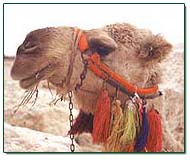 Some friends and family had said that this trip may be a foolish undertaking, others have supported it with great enthusiasm. At the
closest point we shall be 130 km (80 miles) from Iraq but I foresee no problems with that. People in Britain also still associate
Beirut with the constant news headlines telling of death and destruction during their civil war. That was many years ago.
Some friends and family had said that this trip may be a foolish undertaking, others have supported it with great enthusiasm. At the
closest point we shall be 130 km (80 miles) from Iraq but I foresee no problems with that. People in Britain also still associate
Beirut with the constant news headlines telling of death and destruction during their civil war. That was many years ago.
On arrival in Beirut I had arranged for a taxi to meet us at the airport and take us to a hotel which I had booked by phone from England. Not something that I would normally do but certainly something that we were both glad of as we arrived quite late in the evening. The last thing that either of us would have wanted would to have been trying to find a place to stay whilst wandering around the city with rucksacks on. Our hotel, the Pension al-Nazih was a pleasant wee place. Very modest and very small. We entered a small doorway on back street in the Gemmayzeh area of town and went up two flights of brightly lit stairs. There was no reception as such, more of a living room. People sitting, watching Arabic and English TV whilst drinking tea and eating dates. Everyone, irrespective of nationality, acknowledged our arrival and chatted to us, and soon after we were shown to our room. It was $25 for the pair of us, which in backpacking terms is sheer extravagance. The room was spotless and we had a small private bathroom. It was ideal. We left almost all of our gear in the room apart from guidebooks and cameras and headed out as soon as we could. We were both anxious to see more of what Beirut had to offer. Beirut is quite an amazing place to be honest. Home and birthplace to a plethora of contrasts and contradictions it is now emerging after the long and destructive civil war which brought it to its knees. This melting pot of peoples, religion and culture has produced something so wholly agreeable that I loved it from the minute I arrived. Perhaps it is as a result of the war or perhaps it is because Beirut wants to re-establish itself as the party capital of the Middle East but the people everywhere were so very pleasant to us. I have enjoyed travelling through quite a few of the Middle Eastern countries but this was unique. So warm, inviting and rewarding.  A brief walk of only a few hundred metres took us past Roman remains, unbelievable numbers of churches and mosques (on one street we
counted seven) and into an area of town which seemed to be host to nothing more than restaurants and cafes. French, Italian, Japanese
and Middle Eastern cuisine all seemed to be here. Notably missing was American and any sort of junk food. In all the time that we were
here junk food was very lacking. Quite a blessing, although I have to admit to enjoying some myself from time to time.
A brief walk of only a few hundred metres took us past Roman remains, unbelievable numbers of churches and mosques (on one street we
counted seven) and into an area of town which seemed to be host to nothing more than restaurants and cafes. French, Italian, Japanese
and Middle Eastern cuisine all seemed to be here. Notably missing was American and any sort of junk food. In all the time that we were
here junk food was very lacking. Quite a blessing, although I have to admit to enjoying some myself from time to time.
In view of the history of Phoenicians, Egyptians, Romans, Byzantines, Greeks, Arabs, Crusaders and Ottomans (may have missed someone out!) it is little wonder that this place seems to have the best from so many others. We had a cracking meal in a French restaurant and enjoyed watching the people walk by. Most of them were so well dressed and life here seems to be at a far calmer pace than in England. It all just seemed so tranquil. For us it was quite warm and yet compared to their summer this must have been quite cool. Never the less they were almost all sitting out at tables on the streets. The slightly unusual thing for us was that it was past midnight. In England things would be quietening down but it was going full swing here. The next day when we got up and headed out to see more of the city we were struck even more by the contrasts. A huge mosque was being built and employing many cranes and a huge work force, yet within a stones throw there were ruins from some indeterminable time in the past and right across the road from them was a Virgin Megastore. The old and the new were happily co-existing everywhere in this city. We came to learn that the next day was a national holiday. I think that it was Independence Day. What ever it was there was a hefty military presence making itself felt in town. I have to say that I found this all rather exciting and my first thought was that it would be a great photo opportunity. Having been 'lifted' off the streets in Ethiopia, and taken to a most unpleasant police station, for taking photos which made the authorities nervous I knew to be cautious. Generally taking photos of anything military in most countries is ill-advised. 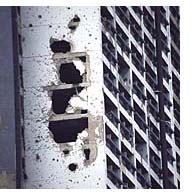 In the mean time we headed off to the Holiday Inn which was only completed and opened a short time before the war began. Its height
made it the obvious choice of snipers which in turn meant that it attracted the full wrath of any opposition. This came in all calibres
and has riddled the outside of the building with holes of varying sizes, from the very small to the sort that you could drive a bus
through. All that remains is the shell of a building.
In the mean time we headed off to the Holiday Inn which was only completed and opened a short time before the war began. Its height
made it the obvious choice of snipers which in turn meant that it attracted the full wrath of any opposition. This came in all calibres
and has riddled the outside of the building with holes of varying sizes, from the very small to the sort that you could drive a bus
through. All that remains is the shell of a building.
When we got near it became obvious that there was a perimeter fence around the whole building at street level and that no one was allowed in. We saw an open gate though, checked our backs, and sneaked on in. We had not anticipated the need for torches when we left our hotel this morning and soon we found ourselves in near total darkness. We had noticed on the way in to the building though that it was just concrete, dust and rubble. What ever had been here had all been plundered and stripped out. We became aware of the fact that there was a party of workmen clearing rubble under an arc lamp so we stayed well out of their way and dodged from one shadow to the next. This would have been a whole lot easier were it not for the rubble, pipes sticking out from the walls or wires trailing from the ceiling. Being impaled or throttled was not on my list of things to achieve on this holiday nor was falling down a lift shaft but we nearly did that too. 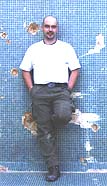 What we really wanted to do was get up a few flights of stairs so that we could get higher in the hotel and see Beirut from a vantage
point. The only stairs we had seen was right by the workmen. We guessed that most of the others had been bricked up to deny access to
snipers during the war or to people like us now. Purely by chance, when Lucy stuck her head into a hole which had been blasted into a
wall, she spotted some stairs. We took off our small day-sacks and squeezed in. We were in total darkness and it was more than slightly
unnerving.
What we really wanted to do was get up a few flights of stairs so that we could get higher in the hotel and see Beirut from a vantage
point. The only stairs we had seen was right by the workmen. We guessed that most of the others had been bricked up to deny access to
snipers during the war or to people like us now. Purely by chance, when Lucy stuck her head into a hole which had been blasted into a
wall, she spotted some stairs. We took off our small day-sacks and squeezed in. We were in total darkness and it was more than slightly
unnerving.
We relied on our camera flashes to show us the way ahead, edging cautiously up four or five flights of stairs and out into a corridor. You could make out the bedrooms and it was by going through the remains of one of these that we found a spiral staircase bathed in daylight. As we went up the stairs, the light became stronger until we found where we were able to peek out at glimpses of the city below. The stairs we had climbed was effectively capped by a huge steel lid. It was like being in a giant dustbin. The reinforced concrete was badly damaged and we were both able to squeeze out of a gap. I have to say that it was a far greater effort for me to do this than for Lucy on account of me being just that little bit larger! We found ourselves on the edge of a large swimming pool. It must have been magnificent but now it was just a pock-marked shell of its former glory. The tiles were riddled with hundreds of bullet holes and shell marks. It was a very vivid reminder of the war. We suddenly became aware of the fact that we were not alone and so slipped into the dry pool to try and hide ourselves. We came to the conclusion that it was most likely squatters who lived here but all the same we did not want to encounter anyone if we could avoid it. We took some photos and some video and then made ourselves quietly disappear the same way that we had come in. When we were walking the last few metres towards the gate we had come in through we saw a man who looked like a worker or possibly even a guard. Not knowing quite what to do we quickened our pace, smiled as we approached and said 'Hello' as we passed. Not looking back we continued out into the bright sun and down the street. We were covered in dust on account of the holes we had climbed through and were grinning from ear to ear like naughty children. It was obvious we had been up to mischief but at the same time we were glad to have seen such a poignant place and to have taken some pretty fantastic photos. Wandering slowly westwards and then south along the coast road eventually takes you to Pigeon Rocks, the most famous natural feature of Beirut. There are plenty of places to get a drink or something to eat and it's where people, particularly hand-holding couples, come to stroll. Countless fishing rods are tended and you have to wonder what all the fuss and effort is for when you see the size (or rather lack of) of the fish that the fishermen reel in. Fresh local breads, corn on the cob and hot nuts are all sold by street vendors who seem to push their carts all day long. Easy enough at this time of year but it must be hard, hard work in the stifling heat of summer here. 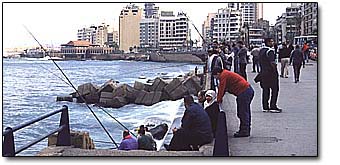 To get to our next destination meant a taxi across town. Beirut is not a big city but as we found out on several occasions it is
desperately difficult to find your way round. The taxi saved a great deal of time. For the first time ever, anywhere in the world,
the taxi driver asked me what I wanted to pay him. I gave him $3 and he was very happy. So was I. Taxis that we took later during
our time here all seemed to charge a flat $5 irrespective of where we were going.
To get to our next destination meant a taxi across town. Beirut is not a big city but as we found out on several occasions it is
desperately difficult to find your way round. The taxi saved a great deal of time. For the first time ever, anywhere in the world,
the taxi driver asked me what I wanted to pay him. I gave him $3 and he was very happy. So was I. Taxis that we took later during
our time here all seemed to charge a flat $5 irrespective of where we were going.
The driving here is not too bad I have to say. Fair enough, if it were your first time out of the UK, you might find it a little concerning but compared to, say, Athens, Cairo or Bangkok it seems quite sedate. It is noisy, ill disciplined and choking but it is also a whole lot of fun. Back to the museum - sorry for the diversion! It is one of the highlights of any trip to Beirut. What makes it so remarkable is the fact that it stands right on the Green Line (the dividing line between Muslims and Christians in the civil war). It was heavily hit by gunfire and shells, as well as being looted, and yet the most significant relics have thankfully remained intact. 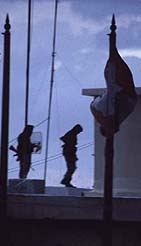 This was down to the foresight of a small group of people who encased as much as they could in reinforced concrete at the outset of war.
When you start your tour of the museum you get a chance to see a short film showing the terrible state of the museum at the end of the
war as well as its restoration. You also get to see original footage of the concrete jackets being taken off the artefacts. It is
quite amazing – well worth seeing.
This was down to the foresight of a small group of people who encased as much as they could in reinforced concrete at the outset of war.
When you start your tour of the museum you get a chance to see a short film showing the terrible state of the museum at the end of the
war as well as its restoration. You also get to see original footage of the concrete jackets being taken off the artefacts. It is
quite amazing – well worth seeing.
The trip round the museum takes you from pre-history, through the Bronze Age, the Hellenistic Period, Romans, Byzantines, Arab Conquest and the Mamluks. It is a relatively small museum but one of the most interesting that I have seen anywhere. A real blessing is the fact that it was not heaving with people. Apart from one tour party we were pretty well the only people there. To get back to our hotel we walked the Green Line. Apparently it was so called because during the war grass and weeds grew here as no one walked across it. We came to learn quite a lot about the war, religion and the way that young Beiruitis see the world as we spent the afternoon and evening drinking with a welcoming group of locals in a very trendy bar which would have seemed equally well placed in West London. A day or so later we woke up in our hotel room and I said to Lucy that I thought I could hear tanks outside. We looked out of the window and sure enough there were all manner of military vehicles driving down the street. It was not yet even 7 a.m. By looking directly across from our hotel window we could also see that there were snipers on almost every roof top. They were not taking any chances with the Independence Day parade today I guess. With Arafat so recently dead another death or assassination in the Middle East could be very bad news indeed. Despite my earlier self-aimed words of caution about taking photos of soldiers and other things military I felt that this was too good an opportunity to pass up. I was pretty confident that I could get a picture or two without being seen from inside my room. I picked up my trusty Nikon, clipped on the 300 lens and started snapping away. Trouble! I had just caught a sniper looking straight down his sights at me. Soon there were two of them looking directly into our room, one on his radio. A couple of minutes later a chap with massive binoculars appeared at the window one floor down and he too was fixed in gaze on our room. Lucy lay in her bed under the window and I lay in mine. I could see what was going on and kept her as up to date as I could. Five minutes later there was a knock at the door. 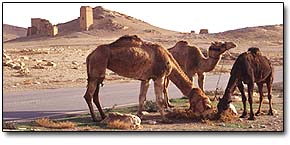 I was only in a pair of shorts and as I gingerly opened the door two burly soldiers stood there with their guns. One was dressed
entirely in black and the other was in regular Army greens. A barrage of questions came my way 'What is your name? Why are you
taking pictures? Where are you from? Where is your camera?' They had obviously been to the hotel reception and seen the register
so they knew that we were British.
I was only in a pair of shorts and as I gingerly opened the door two burly soldiers stood there with their guns. One was dressed
entirely in black and the other was in regular Army greens. A barrage of questions came my way 'What is your name? Why are you
taking pictures? Where are you from? Where is your camera?' They had obviously been to the hotel reception and seen the register
so they knew that we were British.
I was made to hand over my camera and answer more questions to one of them as the other spoke, presumably in Arabic, on his radio. All sorts of thoughts flew through my mind and at the very least I thought that they would take the camera or rip the film from it. However within minutes they handed me the camera back, film intact, uttered some further warning and were then on their way. It seemed that luck was on my side once again. How many lives I have left I have no idea, but it can't be many! When we left the hotel an hour or so later we wanted to go to the parade and take some snaps. There was an armoured car at the end of one of the streets near our hotel so we avoided that and took a different street. A Jeep suddenly came from nowhere to meet us and we were told, in no uncertain terms, that we were not allowed anywhere near the parade and that we had to walk in the opposite direction and not return to the area for at least two hours. It was a shame but the deed was done and there was nothing that we could do about it now. We walked past about half a mile of military vehicles, mainly troop carriers and trucks, which would have made a great photo. I felt though that if I got caught taking more photos we might both be in serious trouble so we decided against it. We were forced though to go and walk through areas of town that we may never otherwise have seen so it was good, apart from the torrential rain! 
After our soaking, we headed back to the hotel. It did cross our minds that soldiers may well have been in the room for a rummage around to double check on us. There was not sign that any of our stuff had been tampered with though. It had also dawned on us that we may well have been followed around when we were out walking but we never saw anyone following us. Perhaps they had been too sly or perhaps it was all just in our minds and we were thinking too much. Either way we agreed that it was time to leave. It just didn't feel the same any more. We made our way to the bus station at the Cola Transport Hub in the south of the city. It was a fair hike with rucksacks on but once again allowed us to see more of this fascinating city. Bus stations in some parts of the world are not really like bus stations as you and I know them to be. More like a collection of MPVs and old Mercedes all of which have seen better days. Sometimes it's more a case of sizing them up to determine which might make the journey rather than which is actually costing the least. In any event our driver picked us (i.e. he ran up the road in the hope that he could interest us in where he was going) and we stood by his vehicle until enough other people were found to make the journey profitable. Yet further people were found en route by his ‘boy’ shouting out of the door to coax passengers from any assembled group of people found along the roadside. Soon enough a bus load of us were on board and rattling and shaking our way along the poorly surfaced roads to Baalbek. 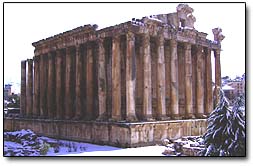 The trip took us across the southern reaches of the Djabal Lubnan which, at its height, rises to around 10,000 feet. A slow
stretch at one summit found us caught in a snow storm, 8cm falling in less than an hour. Driving became precarious
and the few rules of the road that there are were all but forgotten. It was a cold and scary journey but eventually we
reached our destination. A young chap we had met on the bus led us to a hotel owned by one of his relatives and we
negotiated a room for the night. We were very glad of his kindness in view of the fact that it was wet, dark and very, very cold.
The trip took us across the southern reaches of the Djabal Lubnan which, at its height, rises to around 10,000 feet. A slow
stretch at one summit found us caught in a snow storm, 8cm falling in less than an hour. Driving became precarious
and the few rules of the road that there are were all but forgotten. It was a cold and scary journey but eventually we
reached our destination. A young chap we had met on the bus led us to a hotel owned by one of his relatives and we
negotiated a room for the night. We were very glad of his kindness in view of the fact that it was wet, dark and very, very cold.
It stayed bitterly cold throughout the night and despite the kerosene burner in the room the draughty, ill-fitting, single-paned windows ensured that we suffered more than I thought we deserved to. It was suggested that we steer well clear of this town as it is the current HQ of Hezbollah, but we were made to feel as welcome here as we had been everywhere else in Lebanon. The cups of tea and coffee just kept on coming. Customary here as it is in so many countries but after your 12th cup of the day you feel like you just can’t take any more. Waking in the morning from under my heavy, multi-layered and rather off-smelling bedclothes I was elated to see the ruins of Baalbek from our bedroom window. Snow was still gently falling, it seemed like Christmas. There was a real buzz about the town. Heliopolis (one of the former names by which Baalbek was known) means ‘City of the Sun’ and it is described as possibly the most impressive Roman site in the Middle East. It was considered by some as being one of the wonders of the ancient world and the temples were built on such an extravagant scale that it outshone anything in Rome. The site is associated with pagan as well as Christian beliefs and was associated with sexual as well as more conventional rituals. Cults, bloodlust, and sacred prostitution were all practised here. It is recorded as having taken decades to complete the site and it is estimated that over 100,000 slaves were involved in its construction. Building such monuments was far more a political act than a religious one. The Romans liked the locals to believe that they were favouring their gods when in fact they were doing little more than showing off the might of Roman rule and what it could achieve. Looting, sacking, fire and, most notably earthquakes turned the city into the ruined state that meets the visitor today. Still impressive it is only a shadow of what it once was. The hexagonal court, Temple of Jupiter, Temple of Bacchus and Temple of Venus are all awe inspiring and the lesser ruins don't do so badly either. We saw it, unusually, covered in snow and were almost the only people on site. In summer I am certain that it is far more visited. I preferred how we experienced it. 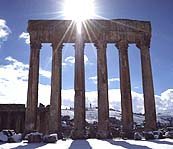 Most people would associate a trip to the Middle East with sun and sand. I have to confess that I had never thought that it would
get so bitterly cold, and was surprised to learn that skiing is popular in many parts of the country. It was winter however, and
a lot of the time we were over 3,000 feet above sea level.
Most people would associate a trip to the Middle East with sun and sand. I have to confess that I had never thought that it would
get so bitterly cold, and was surprised to learn that skiing is popular in many parts of the country. It was winter however, and
a lot of the time we were over 3,000 feet above sea level.
We departed Lebanon from al-Kaa (also called El Qaa. Names here are very transient in their English equivalents). We knew already that we were heading for another potentially tricky afternoon as our visas had in fact expired. On entry to The Lebanon we had opted for a free but very short term visa and we had over-stayed. We had heard stories from travellers regarding the amount that the border guards would try to extort from us for having done so. In the end though, I have to say, that the guards were magnificent, their treatment of us very polite, and the payment very reasonable - about $10 each. It took up about half an hour of our time and in view of the fact we had seen all that we had wanted to in Lebanon (for this trip anyway) it was very worthwhile. In spite of all the good we had seen in Lebanon I was relieved to get to Syria after the ding-dong we had with the army. I had been very tense but now we were in another country and very glad of it. I had heard so many things about Syria that I was really anxious to see and experience some of it for myself. I knew that Lucy felt the same way. We had been travelling together for a good few days now and it all seemed to be going very well. Lucy was a great companion and a fortunate choice of travelling partner, we worked well as a team, I hope I managed to make her feel similarly. After crossing the border another bus drove us on to Homs and there we changed buses yet again, with the help of a local lady, to Marmita which is the nearest town to Krak des Chevaliers. We were encountering serious language difficulties even with English, French, German and a little Spanish spoken between us. We overshot Krak which we saw on a distant hilltop and were unable to stop the bus in time because no one understood what we were trying to say. We ended up going so far past it in fact that we needed to hire another vehicle to get back there as the walk was far too long to manage before night fall. The ride back cost us almost as much as the journey here from Homs. 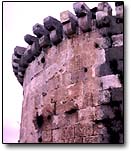 Once again we struck lucky in terms of the location of our hotel, overlooking the castle itself. Just as cold though,
with concrete floors, walls and ceiling, no heating and scant blankets on the beds. Being out of the tourist season there
is little going on here and few places to get anything to eat or drink. We ended up having a cold meal and going to bed
to shiver the night away. It was miserable. There was even a power cut during the night so we lost the one light that we
had as well. We both had torches but the 'concierge' came round with a candle for us. It gave out little heat but at least
it cheered us up.
Once again we struck lucky in terms of the location of our hotel, overlooking the castle itself. Just as cold though,
with concrete floors, walls and ceiling, no heating and scant blankets on the beds. Being out of the tourist season there
is little going on here and few places to get anything to eat or drink. We ended up having a cold meal and going to bed
to shiver the night away. It was miserable. There was even a power cut during the night so we lost the one light that we
had as well. We both had torches but the 'concierge' came round with a candle for us. It gave out little heat but at least
it cheered us up.
The next day we went to visit Krak – a place that I had read about only a year or so ago. It is generally considered to be the finest of all Crusader castles, but remains the only such castle to have been thoroughly investigated and thoroughly restored so perhaps this notoriety is not so remarkable. It occupies a hilltop, overlooking a wide and fertile valley. An Arab villa and fortress already existed here and fell to the Crusaders in 1110. Initially it was dependent on Tripoli but was then given to the military order of the Hospitallers in 1142. In 1188 after the battle of Hattin, in which the Crusaders were defeated, Saladin decided not to beseige Krak and it became the chief stronghold of the Hospitallers. It finally fell to the Sultan Baybars in 1271. The conquerors continued to use the castle, restoring its walls and adding a major new defensive tower. We had acquired a card with the details of our next intended hotel. This meant that we did not have to converse with the driver. He knew where we wanted to go. So often abroad I feel rude or ignorant at not being able to speak the host language but you can't speak 'em all. 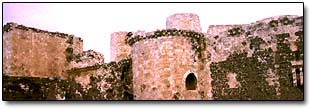 Krak's history is long and complex with various of its inhabitants changing and adding to the structure to make it as it
appears today. No one can deny its sheer physical strength nor the quality of its construction and the subtlety of its
defensive systems. Many would be conquerors simply gave up all thought of taking the castle when they saw it which
surely proves just how awesome it actually is.
Krak's history is long and complex with various of its inhabitants changing and adding to the structure to make it as it
appears today. No one can deny its sheer physical strength nor the quality of its construction and the subtlety of its
defensive systems. Many would be conquerors simply gave up all thought of taking the castle when they saw it which
surely proves just how awesome it actually is.
T.E. Lawrence wrote at length about the structure in his book 'Crusader Castles' as did Alan Borg in his published and well read paper and to whom I owe a debt of gratitude. This paper provided me with an in depth and comprehensive understanding of the structure and its history which added immensely to my own visit. Access to almost all areas of the castle is still possible although I am sure, in the interests of preservation, that this will have to be restricted in the coming years as the numbers of tourists increase. We ourselves found some out-of-the-way stairs which descended into near total darkness for 91 steps, unpassable without a torch. At the very bottom of the stairs which we descended we came to a door. It had been totally silted up by centuries of rainwater carrying debris down the stairs such that only the top arch of the door way remained visible. What lay behind this is anyone's guess. One day I am sure that some better funded and better organised investigation will be executed and whatever lies behind the doorway will be seen once again. 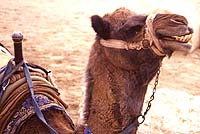 Having spent many hours enjoying Krak we decided to travel on to Palmyra (also known as Tadmor). From Krak it was
quite a trek and we opted for a further luxury. For the sake of $50 (about £28) we hired a private vehicle all
the way. Even so it took a good few hours but it was just us and the driver and it was worth every penny. The journey
was mainly through desert as we headed east and passed Bedu encampments and signs straddling the road which were
pointing to Iraq.
Having spent many hours enjoying Krak we decided to travel on to Palmyra (also known as Tadmor). From Krak it was
quite a trek and we opted for a further luxury. For the sake of $50 (about £28) we hired a private vehicle all
the way. Even so it took a good few hours but it was just us and the driver and it was worth every penny. The journey
was mainly through desert as we headed east and passed Bedu encampments and signs straddling the road which were
pointing to Iraq.
The temperature was noticeably warmer out here in the desert. So glad to be down from the mountains and away from the cold which we were so unprepared for. It took a good few hours to get to Palmayra and as we approached we passed the instantly recognisable ruins of the castle-fortress of Qala'at Ibn Maan. It is probable that some fortification has existed up here for donkeys years but the current building is reckoned to be 17th century and have been built by a Lebanese warlord who challenged the Ottomans for control of the surrounding desert. Quite why anyone would want to live here I am not sure. At first glance it seems so barren but then some deserts do yield up plenty of surprises. Our hotel here was the best yet. Clean sheets, nice place, in the centre of town, no noise and even a view back east to Qala'at Ibn Maan in the distance. Not bad in view of the fact we were only paying $10 per night for the pair of us. That said the owner either tried to cheat us when we left or he was just really poor at maths. Which ever way, I think he got quite a shock when I produced my own bill and it was substantially less than the one he had drawn up. Palmyra is rife with street sellers and whilst everyone has to make a living they really did get a bit much just here. You couldn't move for them. In the height of summer it could be totally unbearable. Mind you in the height of summer it could be that there are so many tourists here that the street sellers are run ragged. We were just an easy target I guess - virtually the only tourists around. The day we arrived we found a café which had e-mail. Not an internet café as we know them back home, just a café with one PC. Now I am no computer whizz but this thing must have had a Pentium 900BC chip in it or something. I have seen quicker sloths. I did manage to send a couple of e-mails but it is easy to see why they still sell postcards here! I got up before dawn, leaving Lucy in her bed, and headed off in search of a coffee and the opportunity to catch up on my journal. The whole town was still asleep, and I could not even get a drink. The cold of night was still lingering and I sat out on the pavement, watching as the town woke and hopeful that the sun would soon get up too to warm me. 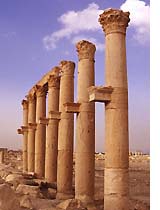 After a slightly unusual breakfast we headed off to the necropoli. These are a large collection of funery
sets of the Roman period. They have been described as the most spectacular graves of the Near East and upon visiting it
is easy to see why. Scattered across a considerable area of desert there are stelae marking individual burials as well as
multi-levelled towers for collective tombs. It seems that only the affluent were buried here as the interiors of the tombs
reveal magnificent carvings and paintings of those buried within. Recesses in the walls called loculi were made to receive
the bodies which were most frequently mummified or wrapped in strips of cloth whilst other bodies would have been placed
in a sarcophagus. Their construction dates from 9BC to 128AD but they were reused over a longer period.
After a slightly unusual breakfast we headed off to the necropoli. These are a large collection of funery
sets of the Roman period. They have been described as the most spectacular graves of the Near East and upon visiting it
is easy to see why. Scattered across a considerable area of desert there are stelae marking individual burials as well as
multi-levelled towers for collective tombs. It seems that only the affluent were buried here as the interiors of the tombs
reveal magnificent carvings and paintings of those buried within. Recesses in the walls called loculi were made to receive
the bodies which were most frequently mummified or wrapped in strips of cloth whilst other bodies would have been placed
in a sarcophagus. Their construction dates from 9BC to 128AD but they were reused over a longer period.
From there we made our way back across the desert, a distance of no real consequence, to the ruins of Palmyra itself. We started at the Sanctuary of Bel. Bel was the supreme deity of Palmyra, linked to Bel Marduk of Mesopotamia and Zeus too. Located at the far eastern stretch of the Great Colonade the Sanctuary of Bel is the most important monument in this city. The walls of its great court were 210 metres long and 205 metres wide. Inside was the Temenos built for worshippers to gather and praise statues of the deity. In its hey-day it must have been a marvel to behold. Now it is still awe inspiring but only a shadow of what it once was. Attempts have been made to restore some of it but they are rather obvious and even the untrained eye (i.e. mine) can tell that it would take a vast sum of money and many years to carry out an accurate and realistic rebuild. That said it is one of the most incredible ancient sites that I have ever had the good fortune to visit. Once again we did so in relative peace with relatively few other visitors. This lack of people allowed us once again to jump down holes and crawl along tunnels that few will ever crawl through. Sewers and access points for slaves and animals no doubt but very exciting to us all the same. Even these tunnels were made of finely carved and well faced stones which gave an indication of just how important this site must have been. 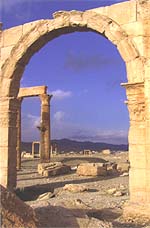 Above ground we ventured out from Bel to see the pantheon, theatre, baths, senate, tetrapylon and countless temples. The
Great Colonade itself is 1.2 km long with porticoes on either side and is surely one of the longest ever constructed.
Interesting snippets of information kept giving themselves up such as the fact that it was never paved so that
camels could use it. Quite why camels have an aversion to paving I do not know and have never managed to find out! We stayed
here until the sun disappeared beyond the horizon and the cold of night started to cloak us. It was time to head back in
search of food, warmth and perhaps even a beer - hard to find but not totally elusive when you looked as keenly as we did!
Above ground we ventured out from Bel to see the pantheon, theatre, baths, senate, tetrapylon and countless temples. The
Great Colonade itself is 1.2 km long with porticoes on either side and is surely one of the longest ever constructed.
Interesting snippets of information kept giving themselves up such as the fact that it was never paved so that
camels could use it. Quite why camels have an aversion to paving I do not know and have never managed to find out! We stayed
here until the sun disappeared beyond the horizon and the cold of night started to cloak us. It was time to head back in
search of food, warmth and perhaps even a beer - hard to find but not totally elusive when you looked as keenly as we did!
When we left Palmyra the next day we were on the Road to Damascus. This time we travelled on a local bus which cost us next to nothing. We were the only foreigners and we were reminded of this every so often as the locals fixed long and quizzical gazes upon us. Never though did we feel threatened, quite the opposite. We felt very welcome, all be it rather unique. The only thing that was threatening on the bus was the smell. I got the distinct impression that washing was not high on the agenda of many. At least it masked how badly I smelled myself. The journey was a good few hours long, through little more than rocky outcrops, distant mountains and lots of sand. Every so often - more sand and more sand. The monotony of the trip was broken by a grubby, ill shaven little man who came round offering water which was drunk by the passengers from shared cups. We had our own. Thankfully. Getting into the heart of Damascus seemed to take an age. First off were the huge industrial areas on the outskirts, then the poor districts, then suddenly some rather European looking streets and then, finally, the town centre. It looked like many other places I have seen but it had a great feel to it. The sun was fading and yet it was still warm. The streets were lined with trees and there were loads of old French cars, mainly Peugeots, hurtling along the streets at speeds which should have been impossible for them to manage. 
We left the bus station, fended off the over-zealous cab drivers and made our way to a small hotel, Nijmet al-Shark, which over looked Al-Merjeh (Martyrs' Square). It was not the place that we had intended to stay but many things turned out other than as we had intended when thinking this all through at home before we left. The hotel was very much a locals place. They spoke almost no English and it was a bit of a challenge to communicate when we arrived. The hotel itself was up a small, dingy staircase which was shared with lots of other small businesses. Had we not been actively looking for it I am sure we would have missed it all together. The room was more than adequate though and had a pretty decent bathroom. We even had the blessing of a sit down loo rather than the customary hole in the floor. We had a balcony which faced the square and afforded us a great view. In view of the fact we were three floors up I didn't take too well to standing out there - I am terrified of heights! We spent the next few days walking round this magnificent city, taking in its sights and smells. There were plenty of both. Steeped in history with ancient streets, a great souq and monumental mosque. The Umayyad Mosque is one of the most magnificent buildings of Islam and the most important religious structure in all of Syria. In sanctity it is only second to the mosques of Mecca and Medina. People have been worshipping on this site for more than 3000 years. Often when travelling the advice I have heard is to avoid talking about religion or politics in certain countries. Here though, in this great building, I found myself doing both and I was so relaxed with it. The funniest thing of all though is that I know comparatively little about either. Perhaps that is why I felt so at ease. It was so apparent to me as well that young people in this country are pretty much the same as me and my friends back home. Wanting to chat, to meet foreigners and to share their views and opinions as well as seeking those of others. Great, great people. With a mausoleum to Salah ad-Din, the shrine of John the Baptist and the shrine of Hussein (grandson of the Prophet), the founder of the Shiite faith there were many reasons to visit this place and consequentially many more visitors than we had seen almost anywhere else. One of my most enduring memories of Syria would have to be sitting down to a large plate of rams testicles on our final night. Not too bad and certainly nothing like I would have imagined them to be. A few beers, a short sleep and then a taxi ride through the dark streets to the airport and the start of our journey home. It was a great trip, to two great countries, with a great travel partner and somewhere that I would recommend anyone to visit. Click here to view the Syria and Lebanon photo gallery! |
|
|